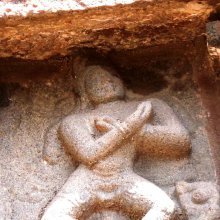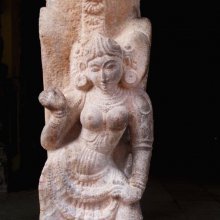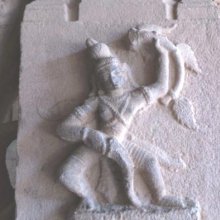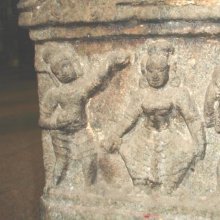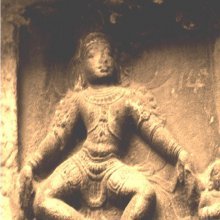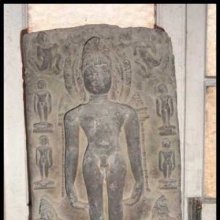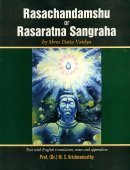Side: 2 definitions
Introduction:
Side means something in Hinduism, Sanskrit, biology. If you want to know the exact meaning, history, etymology or English translation of this term then check out the descriptions on this page. Add your comment or reference to a book if you want to contribute to this summary article.
Images (photo gallery)
(+1113 more images available)
In Hinduism
Natyashastra (theatrics and dramaturgy)
Source: Shodhganga: Elements of Art and Architecture in the Trtiyakhanda of the Visnudharmottarapurana (natya)The Sides refers to one of the major Body Parts with which are associated various gestures and expressions (in Sanskrit Dramas), as conveyed through Āṅgikābhinaya: one of the four divisions of Abhinaya or “ways to convey or represent one’s emotion to others”, according to the Nāṭyaśāstra and the Viṣṇudharmottarapurāṇa, an ancient Sanskrit text which (being encyclopedic in nature) deals with a variety of cultural topics such as arts, architecture, music, grammar and astronomy.—The āṅgikābhinaya includes the histrionic representation of the limbs which is simply known as physical gestures. The aṅgas i.e., major classification of the body parts are six in numbers viz., head, hands, chest, sides, waist and feet.
There are five kinds of side movements accepted in the Viṣṇudharmottarapurāṇa and these are—
- samunnata,
- nata,
- prasārita,
- vivartita and
- apasṛta.

Natyashastra (नाट्यशास्त्र, nāṭyaśāstra) refers to both the ancient Indian tradition (shastra) of performing arts, (natya—theatrics, drama, dance, music), as well as the name of a Sanskrit work dealing with these subjects. It also teaches the rules for composing Dramatic plays (nataka), construction and performance of Theater, and Poetic works (kavya).
Biology (plants and animals)
Source: Google Books: CRC World Dictionary (Regional names)Side in Senegal is the name of a plant defined with Cassia sieberiana in various botanical sources. This page contains potential references in Ayurveda, modern medicine, and other folk traditions or local practices It has the synonym Cassia kotschyana Oliv. (among others).
Example references for further research on medicinal uses or toxicity (see latin names for full list):
· Bull. Mus. Natl. Hist. Nat.
· Prodromus Systematis Naturalis Regni Vegetabilis (DC.) (1825)
· Flora of Tropical Africa (1871)
· Journal of Ethnopharmacology (2001)
· Journal of Ethnopharmacology (2005)
· Journal of Ethnopharmacology (1983)
If you are looking for specific details regarding Side, for example diet and recipes, extract dosage, pregnancy safety, side effects, health benefits, chemical composition, have a look at these references.

This sections includes definitions from the five kingdoms of living things: Animals, Plants, Fungi, Protists and Monera. It will include both the official binomial nomenclature (scientific names usually in Latin) as well as regional spellings and variants.
See also (Relevant definitions)
Starts with: Citeki, Citekkatiram, Citentiram, Citentiriyan, Citevi, Citevipputu, Side oat, Side-saddle-flower, Sidebells wintergreen.
Query error!
Full-text (+29368): Parshva, Ubhayatas, Shuddhakoti, Ubhayatra, Paksha, Shikhanda, Kakapaksha, Parshvatas, Parshvatiya, Parshvastha, Pariparshva, Parshvika, Parshvabhaga, Paravarina, Pakshabhaga, Sapaksha, Anjali, Apasrita, Unnata, Andhamusha.
Relevant text
Search found 574 books and stories containing Side, The side, Sides; (plurals include: Sides, The sides, Sideses). You can also click to the full overview containing English textual excerpts. Below are direct links for the most relevant articles:
Manasara (English translation) (by Prasanna Kumar Acharya)
Chapter 67 - The measures along the plumb lines (pralamba-lakṣaṇa)
Chapter 27 - The nine-storeyed buildings (navatala or navabhūmi)
Chapter 20 - The two-storeyed buildings (dvitala or dvibhūmi)
The Structural Temples of Gujarat (by Kantilal F. Sompura)
2.4. Caulukyan temples at Dhrasanvel < [Appendix A - Description of some undescribed Temples in Gujarat]
2.3. The temple of Nilakantha Mahadeva at Sunak < [Chapter 4 - Structural temples of the Caulukyan period (942-1299 A.D.)]
1.5. The tank or Reservoir (Kunda) < [Chapter 16 - The accessories of the Temple-complex]
Jain Remains of Ancient Bengal (by Shubha Majumder)
Ṛṣabhanātha sculptures with miniature Tīrthaṅkaras and Planetary deities < [Chapter 6 - Iconographic Study of Jaina Sculptural Remains]
Caubisi type of Ṛṣabhanātha sculptures < [Chapter 6 - Iconographic Study of Jaina Sculptural Remains]
Caubisi type of Pārśvanātha Sculptures < [Chapter 6 - Iconographic Study of Jaina Sculptural Remains]
Agni Purana (by N. Gangadharan)
Chapter 242 - Statesmanship fair a king (rājanīti)
Chapter 45 - Characteristics of pedestals and details relating to images
Chapter 29 - Mode of worshipping Hari in the figure called Sarvatobhadra
Pallava period (Social and Cultural History) (by S. Krishnamurthy)
Head-dress of Women (b): Cylindrica cap like Makuta < [Chapter 4 - Material Culture of the People]
Crowns for Men (b): Karanda-makuta < [Chapter 4 - Material Culture of the People]
Head-dress of Men (Tiara) < [Chapter 4 - Material Culture of the People]
Yoga Vasistha [English], Volume 1-4 (by Vihari-Lala Mitra)
Chapter XIX - Mathematical investigation into the diagrams of om < [The om tat sat]
The figures < [The om tat sat]
Chapter LXXVI - The stridor of pushkaravarta clouds < [Book VII - Nirvana prakarana part 2 (nirvana prakarana)]
Related products
(+67 more products available)
